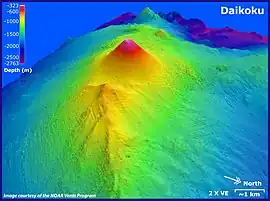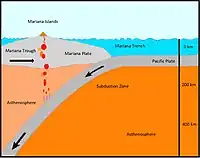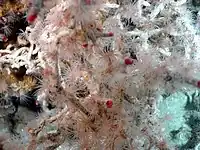| Daikoku Seamount | |
|---|---|
 Bathymetry map of Daikoku | |
| Summit depth | −323 m (−1,060 ft)[1] |
| Height | ~2,180 m (7,152 ft) |
| Location | |
| Range | Izu–Bonin–Mariana Arc |
| Coordinates | 21°19′26″N 144°11′38″E / 21.32389°N 144.19389°E[1] |
| Country | Northern Mariana Islands, United States |
| Geology | |
| Type | Stratovolcanoes |
| Last activity | 2014 |
Daikoku Seamount (Japanese: 大黒海山) is a submarine volcano located in the Northern Mariana Islands, in the western Pacific Ocean. It is part of a chain of volcanoes and seamounts that includes the more known Ahyi Seamount and NW Rota-1 seamounts and is situated about 690 km (429 mi) north of the island of Saipan. Daikoku Seamount rises over 2,500 m (8,202 ft) meters from the seafloor, with its summit about 323 m (1,060 ft) below sea level. Since its discovery, the seamount has been studied by several expeditions, including expeditions made by NOAA, using various scientific tools, such as sonar mapping and remotely operated vehicles (ROVs). Daikoku Seamount is known for its active hydrothermal vent system, which hosts diverse communities of deep-sea organisms, including tube worms, crabs, and snails. The seamount is also one of the only volcanoes along with Nikkō Seamount to have had a partially molten sulfur lake, which is usually a feature seen on Io than on Earth.
Geography
The seamount is located around 850 km (528 mi) north of Guam[1] in the Micronesia region of the Pacific Ocean, a region consisting of hundreds of islands.[2] Morphologically, Daikoku is a volcanic cone sitting on top of an older caldera, which has been almost completely filled during periods of volcanic activity. The modern cone of Daikoku rises around 700 m (2,297 ft) from the caldera base, at a depth of 1,050 m (3,445 ft), and has a 200 m (656 ft) wide summit crater that is slightly breached on the northwest side. At several sites near the summit molten sulfur has been observed, forming both rivulets and ponds. One such pond has been stopped from crusting over by bubbling gases.[3] It has been called the "Sulfur Cauldron" and compared to the sulfur volcanism on Io, a moon of Jupiter.[4]
Geologic setting

The seamount is located in the Mariana Island Arc, a volcanic island arc formed from magma generation in the process of subduction, in which a tectonic plate subsides under another plate. In this case, the Pacific Plate subducts beneath the Mariana Plate through the Mariana Trench, which is the deepest trench in the world. The typical type of volcanoes formed by this subduction are stratovolcanoes. Their structures consist of layers of volcanic ash, pumice, and other volcanic rocks.[5]
Submarine arc volcanoes are the main route by which volatiles, including CO2 (carbon dioxide) and SO2 (sulfur dioxide), released from subducting plates return to the ocean and make up a part of the oceanic volatile budget.[6]
Fauna

The volcano has many hydrothermal vents, which can host various animal species including the one which makes this seamount widely known, the tonguefish Symphurus thermophilus.
On Daikoku, this species lives at depths of 475–320 m (1,558–1,050 ft), which coincide with the locations of hydrothermal vents.[7] These fish are very common and aggregate especially in flat areas with loose sediments. They are bottom-dwelling flatfish, which move frequently in small steps.[8] Large groups of tonguefish occur up to the edge of the sulfur pond, and some fish were observed to swim onto, and pause on, the congealing sulfur, apparently unharmed.[9] Their diet consists mostly of smaller crustaceans and polychaetes.[8]
Also common on the sediment slopes of the seamount are the gastropod Oenopota ogasawarana and hermit crabs. On the sulphur layers at the base of the slope are bythograeid crabs, but no shrimps were found on this seamount.[7]
Tubeworms (Lamellibrachia satsuma) can be found on the slopes of Daikoku at depths of around 400 m (1,312 ft).[10][3] Like the tonguefish, the tubeworms also are mostly found near hydrothermal vents.[11]
Activity

The record of eruptive activity in Daikoku is not known, although it is known that it has erupted in Holocene age with an andesitic composition.[1] However, hydrothermal activity on Daikoku has been continuing for the last two decades, via the emission of high concentrations of gas with high temperatures along with the molten sulfur pond.[12][4] Several expeditions have been carried out by the National Oceanic and Atmospheric Administration (NOAA) over the last few years, and activity was persistent whenever an expedition was there to observe it. In 2014, an eruption was apparently occurring according to high hydrogen concentrations in water samples from above the summit.[13]
2006 expedition
The "Submarine Ring of Fire 2006" expedition took place between April 18 and May 13, 2006, and targeted the exploration of the Mariana Islands volcanoes. On May 4, 2006, the research vessel arrived at Daikoku and deployed the remotely operated underwater vehicle (ROV) Jason. This led to the discovery of the sulfur pond at the summit. Its temperature was measured at 187 °C (369 °F) by a thermometer deployed by the ROV.[4]
2016 expedition
In June 2016, the Okeanos Explorer research vessel was involved in an expedition in the region of the Mariana Islands, and its remote operated vehicle (ROV) made a dive at the Daikoku seamount. Two days before the dive to Daikoku, the Okeanos's sonars detected a strong plume which could have been a hydrothermal bubble plume near the peak of Daikoku. This led to the change of some equipment on the Daikoku dive from the dive on Eifuku.[13]
ROV Deep Discoverer landed on the flanks of the Daikoku Seamount. During the 10-hour dive, the visibility was low due to the smoke from the sulfur vents. Despite that, the ROV was still able to operate. The slopes were reported to be covered with volcaniclastics and volcanic ash. Fumaroles were also found, a feature usual for active volcanoes.[14]
Other than volcanic activity, the animals that live on the seamount were also observed. For the first time, sea anemones were seen growing on the tips of tubeworms in the area.[14]
See also
References
- 1 2 3 4 "Daikoku". Global Volcanism Program. Smithsonian Institution. Retrieved January 7, 2023.
- ↑ "Subregion: Micronesia". AntWeb. Retrieved February 4, 2023.
- 1 2 Embley et al. 2007, p. 77.
- 1 2 3 "Discovery of the Sulfur Cauldron at Daikoku Volcano: A window into an active volcano". NOAA. Retrieved January 7, 2023.
- ↑ "Pagan Island, Northern Mariana Islands". NASA. January 29, 2007. Retrieved January 7, 2023.
- ↑ Embley et al. 2007, p. 70.
- 1 2 Tunnicliffe, Tyler & Dower 2013, p. 175.
- 1 2 Tunnicliffe, Tyler & Dower 2013, p. 177.
- ↑ Tunnicliffe, Tyler & Dower 2013, p. 178.
- ↑ Kojima et al. 2012, p. 146.
- ↑ Kojima et al. 2012, p. 147.
- ↑ Embley et al. 2007, p. 73.
- 1 2 Cantwell & Newman 2016, p. 3.
- 1 2 Cantwell & Newman 2016, p. 4.
Sources
- Embley, R. W.; Baker, E. T.; Butterfield, D. A.; Chadwick Jr., W. W.; Lupton, J. E.; Resing, J. A.; De Ronde, C. E.; Nakamura, K. I.; Tunnicliffe, V.; Dower, J. F.; Merle, S. G. (2007). "Exploring the Submarine Ring of Fire Mariana Arc – Western Pacific". Oceanography. 20 (4): 68–79. doi:10.5670/oceanog.2007.07. JSTOR 24860145.
- Tunnicliffe, V.; Tyler, J.; Dower, J. F. (2013). "Population ecology of the tonguefish Symphurus thermophilus (Pisces; Pleuronectiformes; Cynoglossidae) at sulphur-rich hydrothermal vents on volcanoes of the northern Mariana Arc". Deep Sea Research Part II. 92 (1): 172–182. Bibcode:2013DSRII..92..172T. doi:10.1016/j.dsr2.2013.01.026.
- Kojima, S.; Murakami, S.; Nemoto, S.; Watanabe, H.; Miyake, H.; Tsuchida, S. (2012). "Genetic diversity and population structure of a vestimentiferan annelid Lamellibrachia satsuma in Japanese and northern Mariana waters". Plankton & Benthos Research. 7 (3): 146–150. doi:10.3800/pbr.7.146.
- Cantwell, K.; Newman, J. (2016). Okeanos Explorer ROV dive summary, EX1605L3, June 26, 2016 (Report). NOAA. Retrieved January 7, 2023.